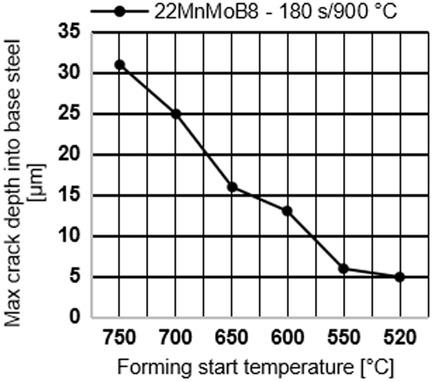当前位置:
X-MOL 学术
›
Steel Res. Int.
›
论文详情
Our official English website, www.x-mol.net, welcomes your
feedback! (Note: you will need to create a separate account there.)
Effect of Steel Composition and Processing Parameters on the Penetration Depth of Microcracks in ZnFe-Coated Boron Steels
Steel Research International ( IF 1.9 ) Pub Date : 2021-03-31 , DOI: 10.1002/srin.202100112 Henri Järvinen 1 , Jari Rämö 1 , Ali Sabr 1 , Sanna Järn 2 , Emmi Lepikko 2 , Martti Järvenpää 2 , Pasi Peura 1
Steel Research International ( IF 1.9 ) Pub Date : 2021-03-31 , DOI: 10.1002/srin.202100112 Henri Järvinen 1 , Jari Rämö 1 , Ali Sabr 1 , Sanna Järn 2 , Emmi Lepikko 2 , Martti Järvenpää 2 , Pasi Peura 1
Affiliation

|
Liquid metal assisted cracking (LMAC) and so-called microcracking are limiting the application of hot-dip galvanized boron steels in the direct press hardening process. This study addresses the role of steel hardenability on the microcracking behavior of ZnFe-coated (galvannealed) boron steels 22MnB5 and 22MnMoB8. Several soaking times and forming start temperatures in the range of 800–520 °C are examined using a laboratory press hardening equipment with a hat-profiled forming tool. The results indicate that the penetration depth of microcracks can be reduced by improving the hardenability of steel, which enables hot forming in austenitic state at exceptionally low temperatures even without accelerated cooling procedures. The austenite decomposition of 22MnB5 leads easily to heterogeneous microstructure (ferrite + austenite/martensite) below the coating/steel interface, which promotes the penetration of microcracks. The crack depth is generally reduced with a conversion-delayed 22MnMoB8 steel; however, a crucial reduction is attained only at lowest hot forming temperatures of 550 and 520 °C. The results of 22MnMoB8 uncouple the effect of high-temperature ferrite formation from the microcracking mechanisms and suggest that the embrittling effect from zinc or zinc-rich intermetallic phases plays a crucial role at conventional hot forming temperatures of 800–600 °C.
中文翻译:

钢成分和工艺参数对ZnFe涂层硼钢微裂纹渗透深度的影响
液态金属辅助开裂 (LMAC) 和所谓的微裂纹限制了热浸镀锌硼钢在直接加压硬化工艺中的应用。本研究探讨钢的淬透性对 ZnFe 涂层(镀锌退火)硼钢 22MnB5 和 22MnMoB8 的微裂纹行为的作用。使用带有帽形成型工具的实验室压力硬化设备检查了 800–520 °C 范围内的几个均热时间和成型开始温度。结果表明,通过提高钢的淬透性可以降低微裂纹的渗透深度,即使没有加速冷却程序,也可以在极低的温度下以奥氏体状态进行热成型。22MnB5的奥氏体分解容易导致涂层/钢界面下方的不均匀组织(铁素体+奥氏体/马氏体),促进微裂纹的渗透。裂纹深度一般用延迟转化的 22MnMoB8 钢减小;然而,只有在 550 和 520 °C 的最低热成型温度下才能实现关键的降低。22MnMoB8 的结果将高温铁素体形成的影响与微裂纹机制分开,并表明锌或富锌金属间相的脆化效应在 800-600°C 的常规热成型温度下起着至关重要的作用。只有在 550 和 520 °C 的最低热成型温度下才能实现关键的降低。22MnMoB8 的结果将高温铁素体形成的影响与微裂纹机制分开,并表明锌或富锌金属间相的脆化效应在 800-600°C 的常规热成型温度下起着至关重要的作用。只有在 550 和 520 °C 的最低热成型温度下才能实现关键的降低。22MnMoB8 的结果将高温铁素体形成的影响与微裂纹机制分开,并表明锌或富锌金属间相的脆化效应在 800-600°C 的常规热成型温度下起着至关重要的作用。
更新日期:2021-03-31
中文翻译:

钢成分和工艺参数对ZnFe涂层硼钢微裂纹渗透深度的影响
液态金属辅助开裂 (LMAC) 和所谓的微裂纹限制了热浸镀锌硼钢在直接加压硬化工艺中的应用。本研究探讨钢的淬透性对 ZnFe 涂层(镀锌退火)硼钢 22MnB5 和 22MnMoB8 的微裂纹行为的作用。使用带有帽形成型工具的实验室压力硬化设备检查了 800–520 °C 范围内的几个均热时间和成型开始温度。结果表明,通过提高钢的淬透性可以降低微裂纹的渗透深度,即使没有加速冷却程序,也可以在极低的温度下以奥氏体状态进行热成型。22MnB5的奥氏体分解容易导致涂层/钢界面下方的不均匀组织(铁素体+奥氏体/马氏体),促进微裂纹的渗透。裂纹深度一般用延迟转化的 22MnMoB8 钢减小;然而,只有在 550 和 520 °C 的最低热成型温度下才能实现关键的降低。22MnMoB8 的结果将高温铁素体形成的影响与微裂纹机制分开,并表明锌或富锌金属间相的脆化效应在 800-600°C 的常规热成型温度下起着至关重要的作用。只有在 550 和 520 °C 的最低热成型温度下才能实现关键的降低。22MnMoB8 的结果将高温铁素体形成的影响与微裂纹机制分开,并表明锌或富锌金属间相的脆化效应在 800-600°C 的常规热成型温度下起着至关重要的作用。只有在 550 和 520 °C 的最低热成型温度下才能实现关键的降低。22MnMoB8 的结果将高温铁素体形成的影响与微裂纹机制分开,并表明锌或富锌金属间相的脆化效应在 800-600°C 的常规热成型温度下起着至关重要的作用。











































 京公网安备 11010802027423号
京公网安备 11010802027423号